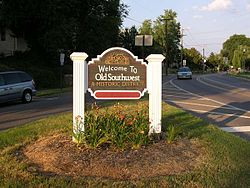History
Annexed from Roanoke County in 1890, [1] the area now defined as Old Southwest was developed primarily between the years 1882 and 1930, to the southwest of Downtown Roanoke. [3] The neighborhood is predominantly residential with commercial generally concentrated along and east of Franklin Road. The neighborhood features a variety of architectural styles including but not limited to Queen Anne, Colonial Revival, Neoclassical, Bungalow, American Foursquare, Arts and Crafts and Shingle, [4] in addition to Roanoke's first public park, Highland Park, opened in 1901. [5]
Old Southwest would grow to become one of Roanoke's premier residential areas from its initial establishment through the years following World War Two when it would see the beginnings of a decline. By the 1970s, the neighborhood would begin to see a turnaround and the subsequent establishment of the Southwest Historic District in 1985. [6] The neighborhood boasts a number of carefully preserved historic buildings, including the Beth Israel Synagogue. More recent improvements to the neighborhood include the completion of the Highland Park dog park, Roanoke's first off-leash fenced dog park, which opened in May 2009, [7] and the opening of the Cotton Mill downtown housing project. [8]
The neighborhood's non-profit civic organization, Old Southwest, Inc, has received several national awards, including the Grand Prize 2010 National Neighborhood of the Year award and First Place in the Social Revitalization category from Neighborhoods USA. [9] It was previously recognized in 2008 with a second place award in the Social Revitalization category from Neighborhoods USA. [10]
This page is based on this
Wikipedia article Text is available under the
CC BY-SA 4.0 license; additional terms may apply.
Images, videos and audio are available under their respective licenses.

